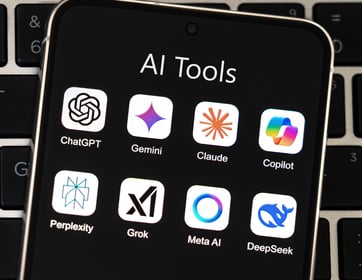Search is changing—and fast. The rise of AI-powered tools and generative search experiences is reshaping how people discover content, ask questions, and choose where to click. This means traditional SEO tactics alone aren’t enough for marketers and business owners. To stay visible and competitive, your strategy must evolve. This guide breaks down how to harness the power of artificial intelligence (AI) within your SEO efforts—so you’re not just keeping up but staying ahead.
The Importance of SEO in an AI-Enabled World
AI is transforming digital marketing at every level, and search engine optimization (SEO) is at the center of that evolution. Business owners and marketers are witnessing how AI is reshaping the way we interpret user behavior, develop content, and remain discoverable in an increasingly competitive online space. While tools and techniques are shifting, the core truth remains—SEO is still essential and, arguably, more important than ever.
Even with AI’s rapid rise, the fundamental mission of SEO remains unchanged: to help people find useful, relevant content when they need it most. What’s different today is how search engines determine what’s relevant. AI enables platforms like Google to go far beyond basic keyword matching. These systems evaluate context, user intent, and behavior to deliver deeply personalized search results. That means content must go beyond surface-level optimization—it has to offer clarity, depth, and purpose.
Search isn’t just a list of links anymore. With features like Google’s Search Generative Experience (SGE), users get AI-generated answers directly on the results page. Today’s digital content must not only rank—it must also deserve to be included in those summaries.
Fortunately, AI-powered SEO tools are more accessible than ever. What once took hours—keyword research, metadata creation, content structuring—can now be done in minutes with platforms like Semrush, Ahrefs, and Surfer SEO. ChatGPT and Frase support idea generation and draft refinement, allowing marketing teams to focus more on strategic execution and less on repetitive tasks.
That said, AI doesn’t replace expertise. High-ranking content still demands authority and originality. Thin, templated articles won’t perform in an environment where search engines increasingly reward real insight. To stay visible, you need to produce relevant, nuanced, and created content with your audience in mind.
AI has also changed how we think about keywords. While still important, keywords now live within a broader landscape of natural language, long-tail queries, and intent-driven search. Content must be conversational, reflecting how real people talk—especially with the rise of voice search.
The technical side of SEO is equally important. Site speed, mobile-friendliness, intuitive navigation, and clean metadata are critical. AI tools can help identify and flag these issues, but they won’t fix them for you. A smart strategy still depends on a solid technical foundation.
Another major shift is predictive SEO. AI’s ability to spot behavioral trends allows marketers to plan content around emerging needs, not just current ones. We’re already using AI-driven insights to help clients anticipate demand, respond faster to market shifts, and lead conversations in their space.
Ultimately, the best SEO strategies blend AI efficiency with human insight. AI can crunch the numbers, test ideas, and scale content, but people still bring the creativity and empathy needed to build trust and connection. In today’s search landscape, trust drives conversions.
Tracking What Matters in SEO
With so much data available, it’s easy to get lost in the numbers. But knowing which metrics matter can help you zero in on what’s working—and what needs attention.
Start with organic traffic. A steady increase usually means your content is gaining traction. Drops or plateaus might indicate issues with search visibility, engagement, or technical performance.
The click-through rate (CTR) shows how compelling your meta titles and descriptions are. Improving your messaging may be the key if your pages rank but no one clicks. Keyword rankings also give insight into your positioning. If your target terms are slipping—or missing—you may need to refresh or expand your content.
Engagement metrics like bounce rate, pages per session, and average time on page tell how users interact with your site. High bounce rates might mean the page isn’t meeting expectations. Low engagement could signal confusing navigation, slow load times, or content that doesn’t resonate.
Technical health is crucial. Google’s Core Web Vitals—load speed, visual stability, and interactivity—now factor into rankings. AI can help identify performance gaps, but resolving them still takes hands-on work.
Backlinks are another key signal. A few links from authoritative, relevant sources carry far more weight than dozens from low-quality sites. Tools like Semrush or Ahrefs help you track these and spot outreach opportunities.
Don’t overlook keyword performance in tools like Google Search Console. Look for the queries bringing the most impressions and clicks. And if you’re investing in SEO, cost per acquisition (CPA) is worth tracking. Divide your SEO spend by the number of organic conversions to gauge how efficiently your strategy turns traffic into results.
In short, AI makes your SEO more precise—but only if you know where to look. Let the data guide your strategy and combine that intelligence with high-quality content and a clear user experience.
Impact of Personalization on Your SEO Strategy
We’re in a new phase of search, one where users expect answers tailored to them. AI drives this shift, and personalization is a cornerstone of SEO success. It’s no longer about ranking for a single keyword—it’s about providing the right experience to the right person at the right time.
Personalization in SEO means adjusting content based on individual behavior, preferences, context, and location. It reflects everything from device type to search history, resulting in search experiences that feel natural—and lead to better performance.
AI powers this behind the scenes. Google uses AI-driven systems like RankBrain and SGE to interpret intent and predict what each user tries to find. This changes the game for marketers. What ranks for one person may not appear for another. Content now needs to resonate across segments.
Delivering personalized experiences also improves SEO outcomes. Relevant content boosts engagement metrics like session duration and return visits—signals that tell search engines your site delivers value.
Tools like Frase, Jasper, and Surfer SEO help optimize content by analyzing what works in your space. They identify patterns in top-performing pages and suggest ways to structure content to meet both search engine expectations and user needs.
Generic content is easy to ignore. Personalized CTAs, dynamic content blocks, and targeted messaging increase engagement. Tailoring your content using first-party data is key, whether it’s a blog post, a product recommendation, or a service page.
Voice and visual search make this even more critical. Users speak to search engines in complete sentences—asking things like “What’s the best camera for hiking under $1,000?”—not just typing keywords. Visual search adds another layer. Platforms like Google Lens prioritize results that match previous behavior and preferences. That’s why your images—and the metadata behind them—need to align with user context.
Segmentation is now standard practice. Divide your content by persona, stage of the buyer's journey, or geographic location. Tools like Google Analytics (GA4), Semrush, or Ahrefs help you understand how different groups engage with your site so you can tailor content more effectively.
To personalize effectively, measure carefully. Track bounce rate, scroll depth, and behavior by audience segment. Use predictive tools and heatmaps to uncover where users engage—and where they drop off. Make changes based on real insights.
Transparency also matters. Users expect to know how their data is used. Build trust by clearly stating your policies, using first-party data, and giving people control over their preferences. Personalization works best when it’s helpful and not invasive.
Personalization is no longer a competitive edge—it’s the standard. The faster you align your SEO strategy to this reality, the more relevant, visible, and impactful your content will be.
Simple Tactics to Boost Your SEO with AI
You don’t need a massive GEO (Generative Engine Optimization) budget to make progress. With a few smart adjustments, you can strengthen your traditional SEO while making your content more accessible to AI-powered search engines. Here are some simple tactics to boost your SEO with AI:
- Start by focusing on long-tail keywords. Users are entering specific, conversational queries that AI tools are especially good at parsing. Look for low-volume but high-intent phrases. Use Google’s “People Also Ask,” AnswerThePublic, and Reddit threads to find common questions.
- Make your content clear and structured. Summarize key takeaways, break content into digestible sections, and add jump links for navigation. Use tools like ChatGPT or Claude to identify ways to simplify and organize your posts.
- Present both sides of a topic. AI prefers balanced, informative content over one-sided sales pitches. Add pros and cons, comparisons, and sections like “When It Might Not Be Worth It” to improve credibility.
- Strengthen your technical SEO. Use schema markup, minimize JavaScript reliance, and ensure fast page speeds. Experiment with tools like llms.txt to guide AI crawlers and help them understand your content.
- Be data-driven. Use original research, internal case studies, and credible sources to support your claims. AI tools are increasingly prioritizing content that’s hard to fake and easy to verify.
- Finally, monitor your performance in AI-driven search environments. Track LLM (large language model) referral traffic, citation counts, and conversion rates from platforms like ChatGPT and Perplexity. Benchmark your visibility against competitors. If they’re showing up in AI results and you’re not, it’s time to act.
How to Stay Informed of Changing SEO Trends
SEO doesn’t stand still. Neither should your strategy. Your team must be aware, adaptive, and proactive to stay relevant. Here are some steps that you can take to stay on top of changing SEO trends:
Start by investing in what you own. A strong email list ensures you maintain direct access to your audience, regardless of algorithm shifts. It also helps drive repeat visits and brand engagement—two indirect SEO benefits.
Foster a culture of experimentation. Dedicate time for research and innovation. Let your team explore semantic SEO, content testing, and generative optimization techniques. Teams that learn continuously are better equipped to respond to changes.
Prioritize users over rankings. Algorithms may change, but Google’s goal remains the same—to deliver the most helpful content. That’s why SEO strategies rooted in real user intent tend to withstand volatility.
Use data to test and refine. A/B test different content types, layouts, or headlines. Measure performance by click-through rate, dwell time, and organic reach. These insights help you scale what works and fix what doesn’t.
Focus on evergreen content. While newsjacking can bring short-term gains, lasting value comes from in-depth, authoritative resources. Prioritize quality and depth over trends.
Keep an eye on emerging tools and platforms. As AI-powered search expands, clarity and structure will matter even more. Optimize for humans and machines using FAQs, long-tail queries, and structured markup.
Above all, stay flexible. Regular audits, strong analytics, and a nimble team will help you adapt without panic.
Adapting your SEO for an AI-powered world isn’t about reinventing everything—it’s about evolving what already works. By combining thoughtful content with the right tools and data, you can build a resilient and future-ready strategy.
Ready to future-proof your digital presence? Contact WSI today to learn how we can strengthen your SEO strategy with AI-powered insights and innovative digital marketing solutions.






